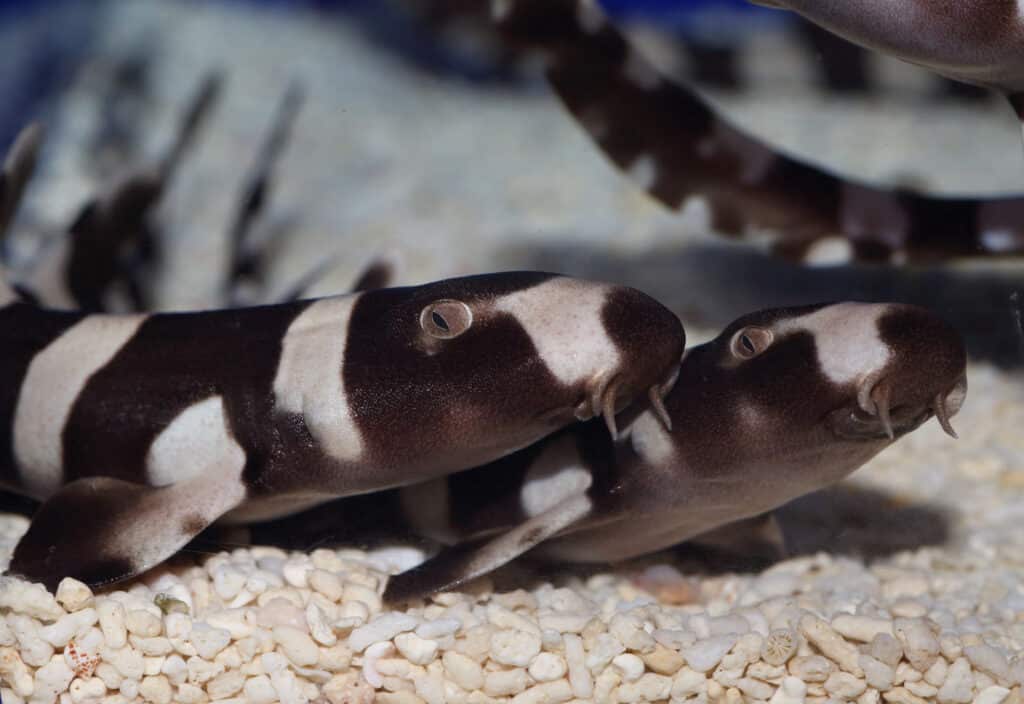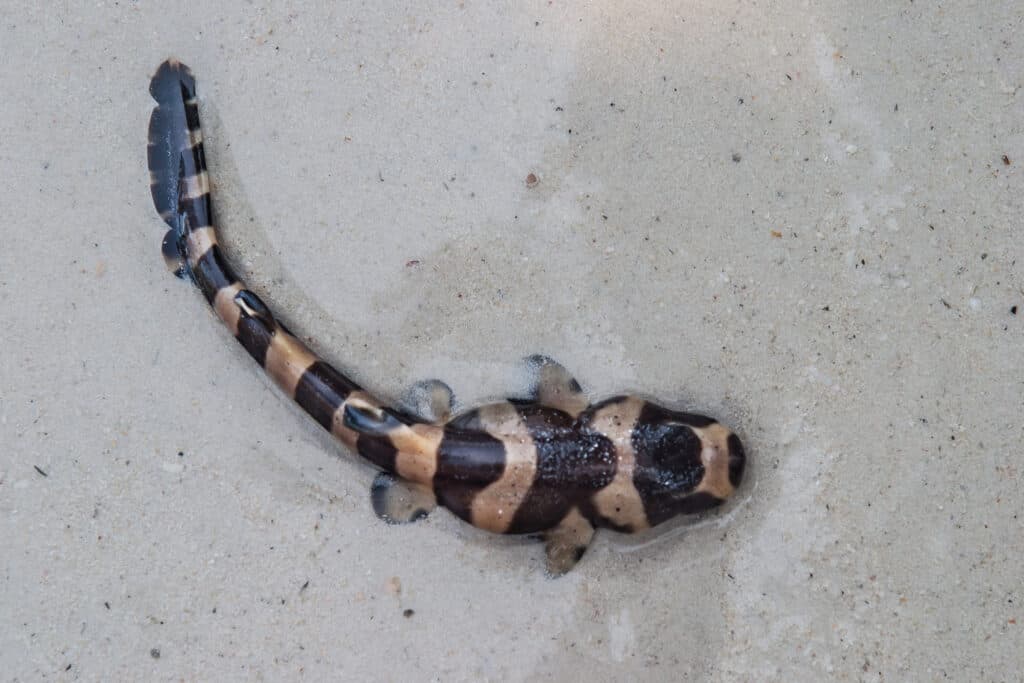Bamboo Shark
Can reproduce asexually
Advertisement
Bamboo Shark Scientific Classification
- Kingdom
- Animalia
- Phylum
- Chordata
- Class
- Chondrichthyes
- Order
- Orectolobiformes
- Family
- Hemiscylliidae
- Genus
- Chiloscyllium
Read our Complete Guide to Classification of Animals.
Bamboo Shark Conservation Status

Bamboo Shark Facts
- Prey
- Fish, crustaceans, mollusks
- Group Behavior
- Solitary
- Fun Fact
- Can reproduce asexually
- Biggest Threat
- Overharvesting
- Most Distinctive Feature
- Tail takes up half of body length
- Distinctive Feature
- Mouth positioned close to eyes
- Other Name(s)
- Longtail carpet shark, cat shark
- Gestation Period
- 14-15 months
- Habitat
- Coral reefs, shallow waters
- Diet
- Carnivore
- Lifestyle
- Nocturnal
- Special Features
- Some bamboo sharks can fold their teeth backward
- Number Of Species
- 7
- Location
- Indo-Pacific
- Nesting Location
- Shallow nests
View all of the Bamboo Shark images!
Also known as carpet sharks or cat sharks, bamboo sharks belong to the family Hemiscylliidae. These small sharks live in shallow waters and coral reefs in the Indo-Pacific. Bamboo sharks are slow bottom-feeders that prey on crustaceans, mollusks, and small fish. Due to their small size, they feature commonly in home and commercial aquariums. However, the IUCN lists them as threatened due to overharvesting and habitat loss.

Under the right circumstances, bamboo sharks can live up to 25 years, although most specimens won’t live this long.
©feathercollector/Shutterstock.com
5 Bamboo Shark Facts
- Some evidence suggests they can breed parthenogenetically, meaning they can reproduce asexually.
- Albino bamboo sharks occur at a rate of around 1 in 10,000 specimens, a much higher rate than other shark species.
- They possess extremely long tails that measure longer than the rest of their bodies.
- It can have up to 67 small teeth, which they use to grab and hold onto small prey.
- Under the right circumstances, they can live up to 25 years, although most specimens won’t live this long.
Classification and Scientific Name
They belong to the order Orectolobiformes. Members of this order often go by the name carpet sharks due to their intricate patterns, which resemble the designs on ornate carpets. In total, the order includes 7 families. These include the nurse sharks (Ginglymostomatidae), collared carpet sharks (Parascyllidae), blind sharks (Brachaeluridae), wobbegong sharks (Orectolobidae), zebra shark (Stegostomatidae, and whale shark (Rhinocodontidae).
They belong to the family Hemiscyllidae. The word Hemiscyllidae derives from the Greek words hemi, meaning “half,” and skylla, meaning “a type of shark.” Roughly translated, the name means “half of a shark,” due to its half-shark, half-fish appearance. The family consists of two genera, Chiloscyllium and Hemiscyllium, but only those in Chiloscyllium typically go by the name bamboo sharks.
The common name “bamboo shark” stems from their long, slender appearance. They also go by several other names, including longtail carpet sharks and cat sharks. The term “longtail carpet shark” refers to their exceptionally long tails. Meanwhile, the name cat shark refers to the barbells near their mouths, which resemble cat whiskers.
The following species go by the name bamboo shark:
- Chiloscyllium arabicum – Arabian carpetshark
- Chiloscyllium burmensis – Burmese bamboo shark
- Chiloscyllium griseum – Grey bamboo shark
- Chiloscyllium hasselti – Hasselt’s bamboo shark
- Choloscyllium indicum – Slender bamboo shark
- Chiloscyllium plagiosum – Whitespotted bamboo shark
- Chiloscyllium punctatum – Brownbanded bamboo shark
Appearance

You can find bamboo sharks throughout the Indo-Pacific.
©Ethan Daniels/Shutterstock.com
Each species varies slightly in terms of appearance. Despite these differences, all share a few similar characteristics. Overall, they possess relatively long snouts and subterminal nostrils. Like all members of Orectolobiformes, they feature five gills, two spineless dorsal fins, and a small mouth. The mouth is positioned close to the eyes, which lie flat along the head. They feature thin, unmuscular pelvic and pectoral fins, hence their rather sluggish rate of movement. The body appears tubular, and the tail takes up at least half or more of the total body length.
Lengths vary depending on the species. The smaller species, such as the Burmese bamboo shark, measure just over 20 inches. Meanwhile, bronwnbanded bamboo sharks can grow up to 41 inches.
They also vary considerably in terms of color. Grey bamboo shark adults appear greyish-brown, and slender bamboo sharks appear brown with dark markings. On the other hand, Hasselt’s and Burmese bamboo sharks don’t usually display a particular color pattern.
Distribution, Population, and Habitat
You can find them throughout the Indo-Pacific. That said, the range varies depending on the species. For example, whitespotted bamboo sharks range from Indonesia to the waters around Japan and India. Meanwhile, Burmese bamboo sharks live in a narrow area off the coast of Myanmar (Burma). They are bottom dwellers that live near coral reefs and shallow waters.
Predators and Prey
Due to their relatively small size, several animals likely prey on them. These include large fish as well as other sharks.
They are bottom-feeders and feed mostly at night, preying on small fish, crustaceans, and mollusks. They rely on electroreceptors in their snouts to help them find prey hiding in sand and mud. Their preferred prey includes fish, shrimp, scallops, and crabs. It uses its rows of tiny teeth to grab and hold onto their prey. Some species possess unique adaptations for feeding on tougher prey. For instance, brownbanded bamboo sharks can reel their teeth backward. This allows them to expose the front surface of their teeth and turn them into a plate for crushing the tough shells of crustaceans.
Reproduction and Lifespan
They are oviparous, meaning that they lay eggs. A female lays a clutch of several eggs in a nest of sandy substrate. For example, brownbanded bamboo shark eggs measure 4.3 to 5.9 inches long and appear flat and long. The eggs take between 14 and 15 months to develop, during which time the embryos feed on the yok within the egg case. Under the right conditions, they can live for nearly 25 years. That said, most specimens likely don’t live this long in the wild.
Food and Cooking
Shark meat is edible, and many cultures frequently eat shark meat. People consume shark both for its supposed health benefit and as a traditional food. Without proper preparation, shark meat tastes rather unpleasant due to its high level of ammonia. To make it more palatable, you must first bleed a shark and then soak it in salt water for a few hours. When prepared properly, shark features a hint of sweetness with moist, not chewy meat. In terms of flavor, some people compare it to chicken or alligator. That said, only a few shark species regularly get eaten. While some people do eat them, it doesn’t rank among the list of regularly eaten sharks.
Population
While exact population numbers aren’t well-known, what is known is that they are quite rare. In the wild, all species face significant threats from overfishing and habit loss. They are caught both as a by-product of commercial fishing and by recreational anglers. Some species, such as the whitespotted bamboo shark and brownbanded bamboo shark, are sometimes kept as pets in aquariums due to their small size and relatively docile, sedentary nature. However, others – such as the Burmese bamboo shark – go unseen in the wild for years.
Due to the threats they face in the wild, the IUCN classifies the brownbanded, whitebanded, and Arabian species as Near Threatened. Meanwhile, the slender, grey, and Burmese species are classified as Vulnerable. Finally, the IUCN lists Hasselt’s as an Endangered species.
View all 284 animals that start with BBamboo Shark FAQs (Frequently Asked Questions)
Are bamboo sharks carnivores, herbivores, or omnivores?
Bamboo sharks are carnivores that eat mostly fresh fish, crustaceans, and mollusks such as scallops. They feed mostly at night and must eat between 2 and 3 times per week.
Do bamboo sharks lay eggs or live young?
Bamboo sharks are oviparous, meaning that they lay eggs. The young bamboo sharks hatch after around 14 to 15 weeks. Amazingly, some evidence suggests that female bamboo sharks may be able to get pregnant without fertilization.
Can you keep bamboo sharks as pets?
Due to their small size and habits, some people keep bamboo sharks as pets. They adapt well to aquariums and breed readily in captivity.
Where can you find bamboo sharks?
Bambo sharks live along coral reefs in the Indian and western Pacific Oceans.
Thank you for reading! Have some feedback for us? Contact the AZ Animals editorial team.
Sources
- , Available here: https://stlzoo.org/animals/fish/orectolobiformes/white-spotted-bamboo-shark
- , Available here: https://www.floridamuseum.ufl.edu/discover-fish/species-profiles/chiloscyllium-punctatum/
- (1970)
















